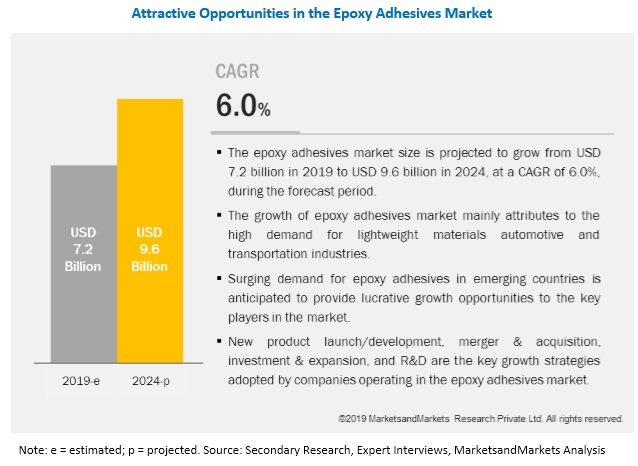The global epoxy adhesives market size is projected to grow from USD 7.2 billion in 2019 to USD 9.6 billion by 2024, at a CAGR of 6.0% between 2019 and 2024. Increasing urbanization growing usage of composites, plastics, and other higher strength metals in the construction industry are driving the global epoxy adhesives market. Epoxy adhesives are used in various applications due totheir exceptional bonding and mechanical & electrical insulating properties and resistance to chemicals andheat.
The key epoxy adhesive market players are Henkel AG (Germany), Sika AG (Switzerland), 3M Company (US), H.B. Fuller (US), DuPont (US), Illinois Tool Works Incorporation (US), Ashland (US), RPM International (US), Lord Corporation (US), Huntsman Corporation (US), Mapie S.p.A. (Italy), Panacol-Elosol GmBH (Germany), Permabond LLC. (UK), Delo Industrie Klebstoffe GmBH & Co. KGAA (Germany), Masterbond Inc. (US), Weicon GmBH & Co. KG (Germany), Hernon Manufacturing Inc. (US), Hubei Huitian New Materials Co. Ltd. (China), Parson Adhesives Inc. (US), and Uniseal Inc. (US). These players have adopted growth strategies, such as new product development, merger & acquisition, and investment & expansion, to expand their geographical presence and broaden their product portfolio.
To know about the assumptions considered for the study download the pdf brochure
Henkel AG (Germany) is one of the leading solution providers for adhesives, sealants, and functional coatings. The company has three business segments, namely, adhesive technologies, laundry & home care, and beauty care. The company manufactures epoxy adhesives under its adhesive technologies segment. Henkel offers a multitude of products to cater to the needs of different target groups: consumers, craftsmen, and industrial businesses. Henkel Adhesive Technologies is a global leader in adhesives, sealants, and functional coatings, worldwide. The complete solution of the company is organized into five technology cluster brands-LOCTITE, BONDERITE, TECHNOMELT, TEROSON, and AQUENCE. It has a strong network for distributing and manufacturing adhesives with 185 production sites in 56 countries to meet the changing demands of the market. The company continuously focuses on its organic & inorganic growth.
In June 2019, the company invested USD 39.4 billion and opened a new European hub for high-performing aerospace solutions in Spain. This expansion has helped to provide high-performance epoxy adhesive solutions for the constantly growing demand and concentrate on the key trends in the global aerospace industry such as light-weighting, fuel efficiency, and automation.
The second-most active company in the epoxy adhesives market is Sika AG (Switzerland). It is a manufacturer and supplier of specialty chemicals with a leading position in the development and production of systems and products for bonding, sealing, damping, reinforcing, and protecting in the building and motor vehicles industries. Sika has a strong customer base and a wide geographical presence. It has subsidiaries in 101 countries and 300 manufacturing facilities, globally. The company has good depth in its product portfolio. There have been significant investments by the company in terms of product innovation. It continuously focuses on organic and inorganic growth for epoxy adhesive systems to increase its presence and revenue, globally. The company has adopted growth strategies such as investment & expansion and merger & acquisitions. In 2018, it established 20 global technology centers, 37 new manufacturing plants, 11 subsidiaries, and completed 20 acquisitions, globally. These developments are expected to help the company achieve a significant share in the epoxy adhesives market. .
In March 2018, Sika introduced SikaPower-4508, a one-component heat curing epoxy adhesive based on flexibilized epoxy resin to the US market.
n September 2016, Sika opened a factory for adhesives and acoustic products in Brazil. This expansion helped the company to tap into the potential of the automotive sector in Latin America by providing products which help in the manufacturing of stronger, safer, and low noise vehicles.



